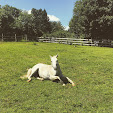Friday night, we went to a Kabbalat Shabbat service at the 770 synagogue, where the Lubavitcher rebbe prayed while he was alive. It was my first time in a synagogue with separate seating. The women's seating was in a balcony above the main floor, allowing one to see everything below through plastic windows. The men's section was a sea of long black coats and hats punctuated by white shirts, which the rabbi's younger sister lovingly compared to an Oreo factory. There was a banner on the wall reading "yechi adoneinu moreinu v'rabeinu melech moshiach l'olam." (A rough translation = Long live our master, our teacher, and our rabbi King Messiah forever). "Rabeinu" refers to the Lubavitcher rebbe; a fringe of Chabad believes the Rebbe, who has been dead nearly 15 years, is the messiah and is just in hiding. It was odd, I thought, but then I saw the yellow flags with red crowns that are widespread in Crown Heights.
My next exposure to the Rebbe happened when visited his tomb (also called the Ohel, or the Tent) in Queens on Saturday night. We entered a visitor's center whose entryway roughly resembled a large white tent with fluorescent lighting. Visitors were instructed to remove their leather shoes and wear Crocs (stored in several sizes on a plain shoe rack) and dress modestly; married women were urged to cover their hair. Before we stepped into the tomb itself, we sat down and some people wrote letters to the Rebbe to place at the Ohel.
The idea is that a Tzaddik (righteous person), even in death, can act as an intermediary between the living and G-d. It makes sense if you think about people who leave letters at gravesites in non-Jewish cemeteries or Catholics who pray to saints, but I couldn't do it. It felt weird. I think the Rebbe was an admirable person, but I don't feel close enough to him to write him a letter. Reciting a psalm at the Ohel itself made more sense, because I was talking directly to G-d, and one of his righteous just happened to be nearby.
After we left the Ohel and did a ritual hand washing, we returned to the visitor center to take off our Crocs and put our regular shoes back on. And then, having visiting the burial site of the leader of one of the most prominent Chassidic movements… we gathered for group photos. In the last one, we made silly faces. I'm still not sure what to make of it. Was it a testament to the Rebbe's loving spirit? Or simply the product of gathering a bunch of enthusiastic college students? Probably more the latter, but I'd like to think it was a bit of both.

No comments:
Post a Comment